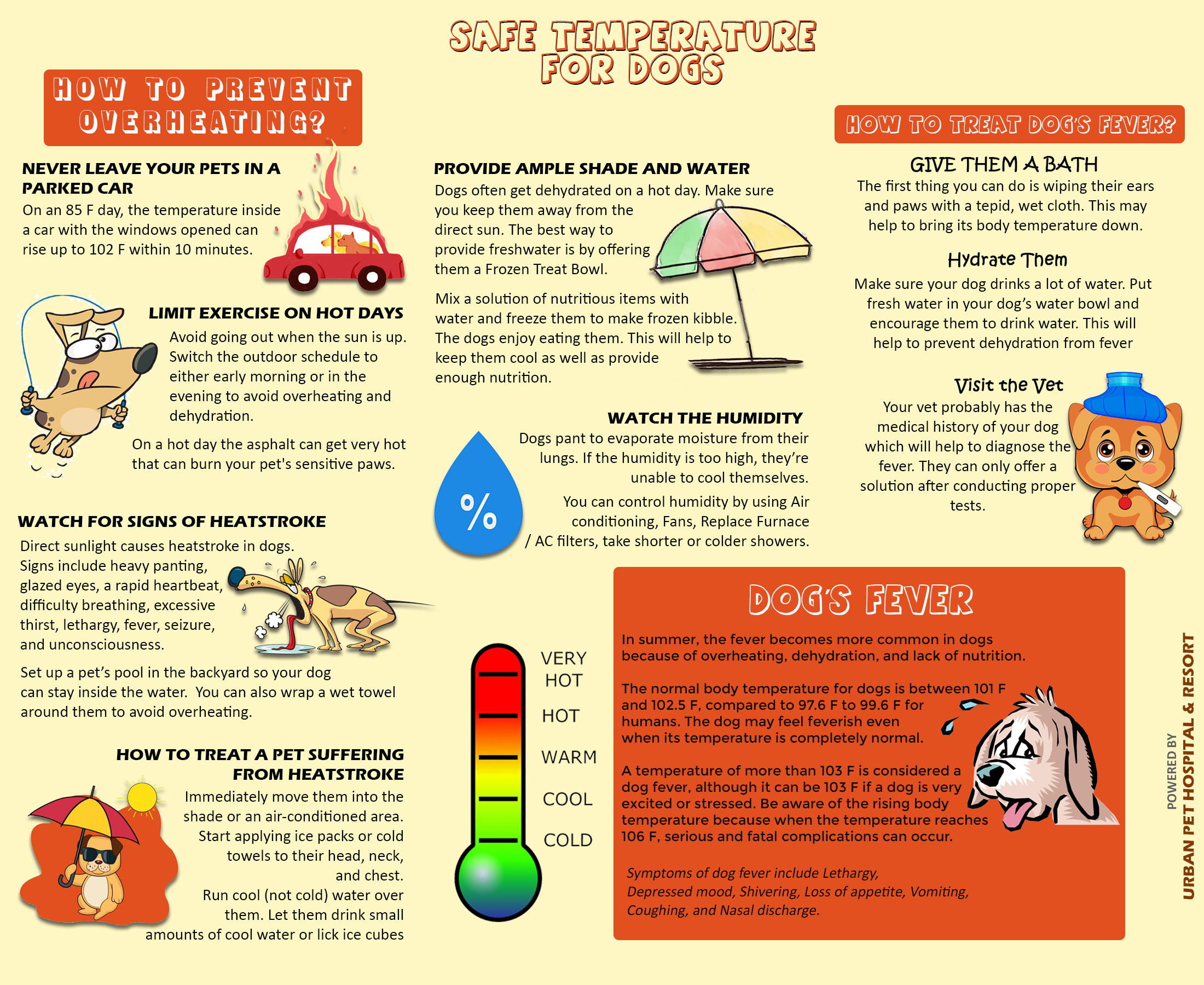
Did you know that dogs can easily overheat when left in the sun? Like humans, dogs are prone to overheating and physical illness when the temperature rises above the normal.
There are many factors that determine the dog’s body temperature. One of the major reasons for overheating is the hot weather. If dogs are let out for a long time, they’ll quickly overheat and start dehydrating.
Dogs only sweat through sweat glands in the pads of their feet and noses. Unlike humans who sweat throughout the body, dogs lessen their body heat by continuous panting which isn't super-efficient so they can quickly become overheated.
Let’s learn more about overheating in dogs and how to control their temperature.
How to keep them safe from Overheating?
Here is how you can avoid your dog from overheating.
Never leave your pets in a parked car
Many pet owners choose to leave their pets inside the car! This can be fatal! You shouldn’t leave them inside a car even for a minute! Many owners claim that they keep the air conditioner on or windows open but this doesn’t help either. On a warm day, the temperatures inside a car can rise rapidly to dangerous levels. On an 85F day, the temperature inside a car with the windows opened can rise up to 102 F within 10 minutes.
It can easily lead to overheating and your pet may suffer irreversible organ damage or even die. It’s better to keep them on a leash and tie them somewhere near under the shade.
Watch the humidity
Dr. Barry Kellog, VMD of the Humane Society Veterinary Medical Association claims that,
"It's important to remember that it's not just the ambient temperature, but also the humidity that can affect your pet. Animals pant to evaporate moisture from their lungs, which takes heat away from their body. If the humidity is too high, they are unable to cool themselves and their temperature will skyrocket to dangerous levels—very quickly."
Some easy ways to control humidity includes
- Air conditioning
- Fans
- Replace Furnace / AC filters.
- Take shorter or colder showers.
Limit exercise on hot days
Although your dog loves to play outside, you should consider limiting outdoor visits during summer. It’s better to avoid going out when the sun is up. Instead, you can switch the outdoor schedule to either early morning or in the evening. On a hot day the asphalt can get very hot that can burn your pet's sensitive paws. If you’re stepping outside during a hot day, consider carrying water with you to keep your dog from dehydrating. Use dog shoes and Vaseline to avoid heat burn.
If you often allow your do to exercise outside, you can consider bringing them in during summer.
Provide ample shade and water
Dogs often get dehydrated on a hot day. The lack of water consumption can easily lead to overheating and dehydration. Make sure you keep them away from the direct sun. Keep them inside and provide ample fresh cold water to keep their body heat in check. The best way to provide fresh water is by offering them a Frozen Treat Bowl. Make a solution of nutritious items and water and freeze them to make frozen kibble. The dogs enjoy eating them. This will help to keep them cool as well as provide enough nutrition.
Watch for signs of heatstroke
Overheating can invite heatstroke in dogs. This is why you shouldn’t let your dog stay outside for a longer duration of time. The signs of heatstroke include heavy panting, glazed eyes, a rapid heartbeat, difficulty breathing, excessive thirst, lethargy, fever, seizure, and unconsciousness.
The best way to avoid heatstroke is by setting up a pet’s pool in the backyard so your dog can stay inside the water. You can also wrap a wet towel around them to avoid overheating.
How to treat a pet suffering from heatstroke
When you notice that your dog is suffering from heatstroke, immediately move them into the shade or an air-conditioned area. Start applying ice packs or cold towels to their head, neck, and chest or run cool (not cold) water over them. Let them drink small amounts of cool water or lick ice cubes.
If the problem seems persistent, consider taking them directly to a veterinarian.
How to measure dog temperature?
There are telltale signs that your dog is overheating; excessive panting, lying on the floor motionless, or slowed breathing. It could easily turn into a fever and can be detrimental to their health but there’s no easy way to say this. You need to take your dog’s temperature to determine if it’s really overheating.
The thermometer should be placed in its bum to measure body temperature. As it can often be difficult to keep your dog still, it’s best if two people together on this particular project.
Before placing the thermometer, you should lubricate it well with Vaseline.
Raise its tail and push the thermometer into its rectum with a twist. It should go in one-three inches, depending on the size of your dog.
Hold it in place for two minutes, then remove it, wipe it quickly, and read the temperature.
Dog’s Fever
Fever is common in dogs throughout the year. However, in summer the fever becomes more common because of overheating, dehydration, and lack of nutrition. The normal body temperature for dogs is between 101 and 102.5 F, compared to 97.6 to 99.6 F for humans. This implies that dogs may feel feverish even when its temperature is completely normal. A temperature of more than 103 F is considered a dog fever, although it can be 103 if a dog is very excited or stressed.
Be aware of the rising body temperature because when the temperature reaches 106 F, serious and fatal complications can occur.
Although there are no definite signs, some symptoms for fever in dogs include:
- Lethargy
- Depressed mood
- Shivering
- Loss of appetite
- Vomiting
- Coughing
- Nasal discharge
How to treat Dog’s Fever?
Here are some handy tips to treat dog fever.
Give them a bath
The first thing you can do is wiping their ears and paws with a tepid, wet cloth. This may help to bring its body temperature down.
Consider giving them a tepid bath. Ensure that the water isn’t ice cold. You can water a bit colder than lukewarm. Apply water to its ears, paws, chest, and abdomen. You can avoid using soap.
Hydrate them
Make sure your dog drinks a lot of water. Put fresh water in your dog’s water bowl and encourage them to drink water. This will help to prevent dehydration from fever.
Visit the Vet
Your vet probably has the medical history of your dog which will help to diagnose the fever. They can only offer a solution after conducting proper tests including a physical exam, urinalysis, blood count, or a biochemistry profile. This will help to ascertain the exact reason for the fever and provide a proper solution. Many times, the fever in dogs is caused by an underlying infection but simply overheat.
Here is a quick Infographics for the brief information.

Urban Pet Hospital & Resort is the best pet hospital in Des Moines. We provide both mobile and on-location emergency services for pets. Our certified veterinarian will ensure that your pet is immediately treated for overheating, dehydration, or fever. Get in touch with us to learn more about precautionary measures for overheating.